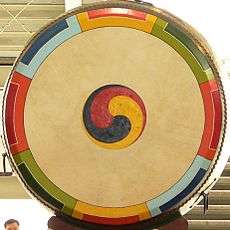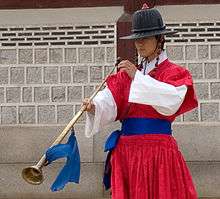Traditional Korean musical instruments
Traditional Korean musical instruments comprise a wide range of string, wind, and percussion instruments. Many traditional Korean musical instruments (especially those used in Confucian ceremonies) derive from Chinese musical instruments.

Buk, Korean traditional drum
String
Korean string instruments include those that are plucked, bowed, and struck. Most Korean string instruments use silk strings, except as noted.
Plucked
Zithers
- Gayageum (hangul: 가야금; hanja: 伽倻琴) – A long zither with 12 strings; modern versions may have 13, 15, 17, 18, 21, 22, or 25 strings
- Geomungo (hangul: 거문고) – A fretted bass zither with six to eleven silk strings that is plucked with a bamboo stick and played with a weight made out of cloth
- Daejaeng (hangul: 대쟁; hanja: 大筝) – A long zither with 15 strings, slightly larger than the gayageum; it was used during the Goryeo period but is no longer usedphoto
- Seul (hangul: 슬; hanja: 瑟) – A long zither with 25 strings, derived from the Chinese se; used today only in Munmyo jeryeak (Korean Confucian ritual music)photo
- Geum (hangul: 금; hanja: 琴) – A 7-stringed zither, derived from the Chinese guqin; also called chilheyongeum; used today only in Munmyo jeryeak (Korean Confucian ritual music)photo
- Ongnyugeum (hangul: 옥류금; hanja: 玉流琴) – A large modernized box zither with 33 nylon-wrapped metal strings, developed in 1973; used only in North Korea (pronounced ongryugeum in North Korea)photo 1photo 2photo 3
Harps
- Gonghu (hangul: 공후; hanja: 箜篌) – Harps (no longer used). There were four subtypes according to shape:
- Sogonghu (hangul: 소공후; hanja: 小箜篌; literally "small harp") – harp with angled sound box, 13 strings, and a peg that is tucked into the player's beltphoto
- Sugonghu (hangul: 수공후; hanja: 豎箜篌; literally "vertical harp") – vertical harp without sound box and 21 strings photo
- Wagonghu (hangul: 와공후; hanja: 臥箜篌; literally "lying down harp") – Arched harp with a large internal sound box and 13 strings, similar to Burmese saung gauk photo
- Daegonghu (hangul: 대공후; hanja: 大箜篌) – large vertical harp with 23-strings
Lutes
- Bipa (hangul: 비파; hanja: 琵琶) – A pear-shaped lute with five strings (hyangbipa or jikgyeongbipa) or four strings (dangbipa). Uncommon today; most modern recreations are modelled on the Chinese pipa
- Wolgeum (hangul: 월금; hanja: 月琴) – A lute with a moon-shaped wooden body, four strings, and 13 frets; no longer used
- Oungum (hangul: 어은금) – A pear-shaped lute with five strings similar to hyangbipa; used only in North Korea
Bowed
Fiddles
- Haegeum (hangul: 해금; hanja: 奚琴) – A vertical fiddle with two strings; derived from the ancient Chinese xiqin
- Sohaegeum (hangul: 소해금; hanja: 小奚琴) – A modernized fiddle with four strings similar to a modern violin; used only in North Korea
- Junghaegeum (hangul: 중해금; hanja: 中奚琴) - A modernized fiddle with four strings similar to a modern viola; used only in North Korea[1]
- Daehaegeum (hangul: 대해금; hanja: 大奚琴) - A modernized fiddle with four strings similar to a modern cello; used only in North Korea[2]
- Jeohaegeum (hangul: 저해금; hanja: 低奚琴) - A modernized fiddle with four strings similar to a modern double bass; used only in North Korea[3]
Zithers
Struck
- Yanggeum (hangul: 양금; hanja: 洋琴) – A hammered dulcimer with metal strings, struck with bamboo mallets; derived from the Chinese yangqin
Wind
Flutes
Transverse
- Daegeum (hangul: 대금; hanja: 大琴 or 大笒) – A large transverse bamboo flute with six finger-holes and an additional hole covered by a buzzing membrane
- Junggeum (hangul: 중금; hanja: 中琴 or 中笒) – A medium-sized transverse bamboo flute with six finger-holes, without a buzzing membrane; rarely used today
- Sogeum (hangul: 소금; hanja: 小琴 or 小笒) – A small transverse bamboo flute with six finger-holes, without a buzzing membrane
- Dangjeok (hangul: 당적; hanja: 唐笛) – A small transverse bamboo flute of Tang Chinese origin, slightly smaller than the junggeum
- Ji (hangul: 지; hanja: 篪) – An ancient transverse bamboo flute with a protruding notched blowhole and five finger holes (one in the back and four in the front), derived from the Chinese chí. Used only in aak and Munmyo jeryeak (Korean Confucian ritual music)
End-blown
- Danso (hangul: 단소; hanja: 短簫) – A small notched vertical bamboo flute with four finger-holes
- Tungso (hangul: 퉁소; hanja: 洞簫) – A long notched vertical bamboo flute with five finger-holes; originally called tongso
- Jangso (hangul: 장소; hanja: 長簫) - A longer notched vertical bamboo flute with five finger-holes
- Yak (hangul: 약; hanja: 籥) – A notched vertical bamboo flute with three finger-holes; used in Munmyo jeryeak (Korean Confucian ritual music)
- Jeok (hangul: 적; hanja: 篴)
- So (hangul: 소; hanja: 簫) – A pan flute; derived from the Chinese paixiao; used only in Munmyo jeryeak (Korean Confucian ritual music
Oboes
- Piri (hangul: 피리) – A cylindrical oboe with a bamboo body. There are four varieties of piri:
- Taepyeongso (hangul: 태평소; hanja: 太平簫; also called hojeok, saenap or nallari) – A conical oboe with a wooden body and metal bell
Free-reed
- Saenghwang (hangul: 생황; hanja: 笙簧) – A free-reed mouth organ with 17 bamboo pipes, derived from the Chinese sheng; uncommon today
- Ungul (hangul: 우; hanja: 竽) – A large mouth-organ, derived from the Chinese yu; no longer used
- Hwa (hangul: 화; hanja: 和) – A mouth organ with 13 bamboo pipes, derived from the Chinese he; no longer used

A player of the nabal
Percussion
Chimes
- Jong (hangul: 종; hanja: 鐘) – A bronze bell
- Pyeonjong (hangul: 편종; hanja: 編鐘) – A set of 16 tuned bronze bells used in ancient court music; derived from the Chinese bianzhong
- Teukgjong (hangul: 특종; hanja: 特鐘) – A single large bronze bell
- Pyeongyeong (hangul: 편경; hanja: 編磬) – A set of 16 tuned stone chimes used in ancient court music; derived from the Chinese bianqing
- Teukgyeong (hangul: 특경; hanja: 特磬) – A single large tuned stone chime
- Banghyang (hangul: 방향; hanja: 方響) – A metallophone with 16 tuned iron slabs; derived from the Chinese fangxiangphoto
- Ulla (hangul: 운라; hanja: 雲鑼 or 雲羅) – A set of ten small tuned gongs in a wooden frame; derived from the Chinese yunluophoto
Drums
- Buk (hangul: 북) – A barrel drum used primarily in pansori, pungmul, and samulnori. The term buk is also used in Korean as a generic term to refer to any type of drum.
- Janggu or Janggo (hangul: 장구 or 장고; hanja: 杖鼓 or 長鼓) – A double-headed hourglass-shaped drum generally played with one stick and one hand
- Galgo (hangul: 갈고; hanja: 羯鼓) – Double-headed hourglass-shaped drum similar to the janggo but played with two sticks and thinner drum heads; sometimes called yanggo or yangjanggo; no longer commonly used
- Jingo (hangul: 진고; : 晉鼓) – Largest barrel drum
- Jeolgo (hangul: 절고; hanja: 節鼓) – Barrel drum
- Jwago (hangul: 좌고; hanja: 座鼓) – A barrel drum in a wooden frame
- Geongo (hangul: 건고; hanja: 建鼓) – Huge barrel drum
- Yonggo (hangul: 용고; hanja: 龍鼓) – A barrel drum with a dragon painted on its shell; used in daechwita
- Eunggo (hangul: 응고; hanja: 應鼓) – Barrel drum suspended from a frame
- Sakgo – (hangul: 삭고; hanja: 朔鼓) – A long barrel drum suspended from a wooden frame
- Gyobanggo (hangul: 교방고; hanja: 敎坊鼓) – Flat drum suspended from a frame
- Junggo (hangul: 중고; hanja: 中鼓) – Flat drum suspended from a frame; similar to the gyobanggo but larger
- Sogo (hangul: 소고; hanja: 小鼓) – A small hand-held drum
- Nogo (hangul: 노고; hanja: 路鼓) – A set of two drums pierced by a pole
- Nodo (hangul: 노도; hanja: 路鼗) – A set of two small drums on a pole, which is twisted to play; used in ritual music
- Yeongdo (hangul: 영도; hanja:靈鼗) – Four drums on a pole, which is twisted to play; used in ritual music
- Noedo (hangul: 뇌도; hanja: 雷鼗)) – six small drums hung in a frame; used in ritual music
- Noego (hangul: 뇌고; hanja: 雷鼓) – Three small barrel drums on a pole, which is twisted to play; used in ritual music
- Do (도) – single pellet drum on a pole
Gongs
Cymbals
- Jabara (hangul: 자바라; also called bara, bal, or jegeum) – pair of large brass cymbals, The name Zabara comes from Calpara.
Wooden Instruments
- Bak (hangul: 박; hanja: 拍) – A wooden clapper; used in ancient court and ritual music
- Bu (hangul: 부; hanja: 缶) – A clay pot, derived from the Chinese fǒu; used in Munmyo jereak
- Chuk (hangul: 축; hanja: 柷) – A wooden box, played by hitting a stick on the inside, used to mark beats or sections; derived from the Chinese zhù; used in ancient ritual music
- Eo (hangul: 어; hanja: 敔) – A wooden percussion instrument carved in the shape of a tiger with a serrated back, played by running a bamboo whisk across it to mark the ends of sections; derived from the Chinese yǔ
- Guhyeon – a jaw harp derived from the Chinese kouxian.
gollark: (this is not final)
gollark: Now, we must satisfy palaiologos, so... raw x86 machine code, PHP, Rust and Python.
gollark: Great!
gollark: I would only ever choose serious languages, like PHP.
gollark: Well, as they say, lament the turbofish.
See also
| Wikimedia Commons has media related to Traditional Korean musical instrument. |
- Akhak Gwebeom
- Korean music
- String instruments
References
- ko:중해금
- ko:대해금
- ko:저해금
- "대피리 - 나무위키". namu.wiki. Retrieved 2019-03-18.
External links
- Korean string instruments
- Korean bamboo wind instruments
- Korean drums
- Korean wind instruments
- Korean percussion instruments
- Korean string instruments
- North Korean instruments
Listening
Video
- Korean instruments videos from Robert Garfias site
This article is issued from Wikipedia. The text is licensed under Creative Commons - Attribution - Sharealike. Additional terms may apply for the media files.